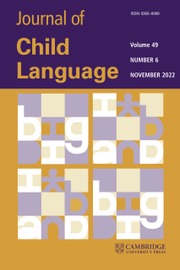Article contents
Count/mass category acquisition: distributional distinctions in children's speech*
Published online by Cambridge University Press: 17 February 2009
Abstract
The count/mass distinction represents a categorical differentiation of nouns into count nouns which can be individuated when quantified (e.g. a car, several tables) and mass nouns which may not (cf. *a water, *several sands). The emergence of this distinction was examined in the longitudinal speech data of two children. In the first analysis, use of count nouns and mass nouns was compared in noun phrase contexts that require count nouns (e.g. a X, another X). It was found that from the earliest samples children used more count nouns in these contexts, hence showing a distributional distinction of noun types. This result suggests very rapid acquisition of count/mass subcategories. A series of further analyses assessed the possibility that early differentiation of count and mass nouns may be due to rote learning. No evidence was found for this proposal. A final analysis examined the development of a rule that requires that singular count nouns must be modified by a determiner. Acquisition here was found to be more protracted in nature since determiners are not used consistently in ‘telegraphic’ speech. Problems concerning the learnability of the obligatory determiner rule are discussed along with some speculations concerning the role of semantics in the acquisition of the count/mass distinction.
- Type
- Articles
- Information
- Copyright
- Copyright © Cambridge University Press 1988
Footnotes
The research reported here was part of a doctoral dissertation in the Psychology Department at MIT. The author wishes to thank Susan Carey, Steven Pinker, Lila Gleitman, Liz Spelke and Virginia Valian for helpful comments. Special thanks go to Susan Ervin-Tripp for making available the data for the analyses.
References
REFERENCES
- 39
- Cited by


